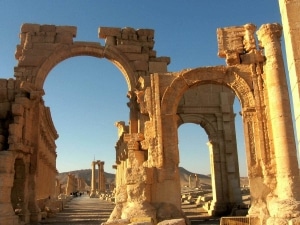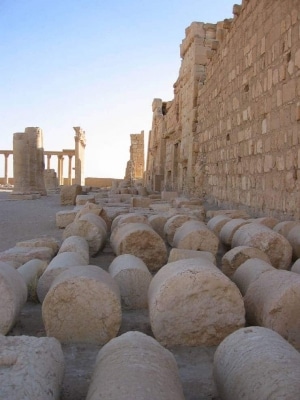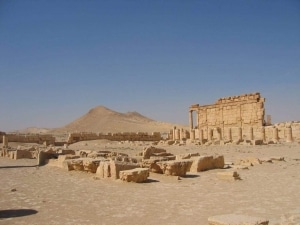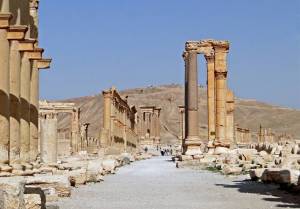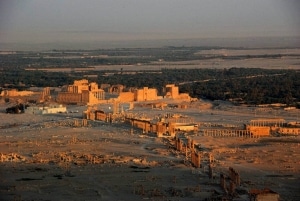Palmyra
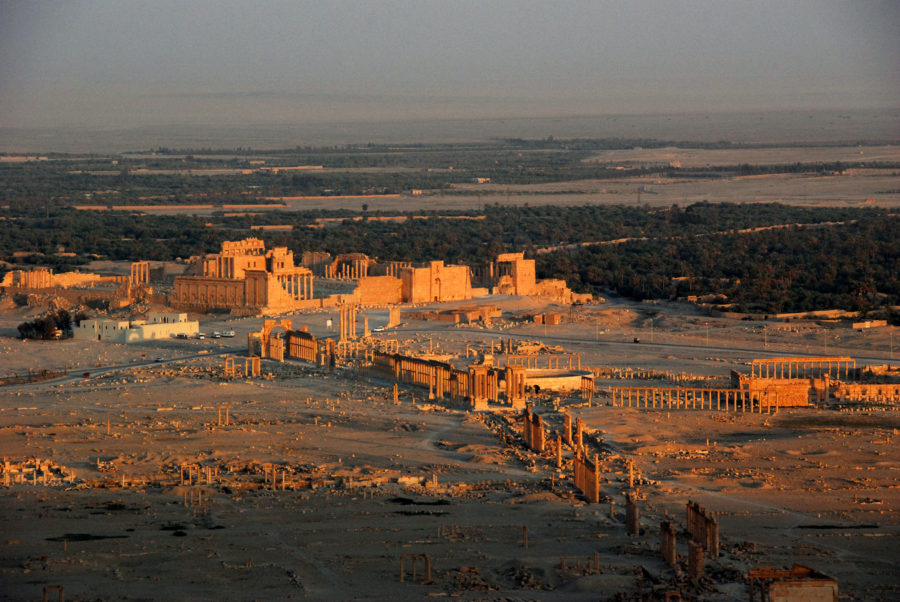
Palmyra or Tadmur, Province of Homs
Syria
Description of the Site
For merchants and others who traveled in between the Euphrates and the sea, Palmyra, located in the center of these two water sources, was a much needed place to recharge. Over the years this oasis in the desert turned into a buzzling trading hub and a cultural center of the ancient world. Palmyra contained/contains the monumental ruins of several civilization.
A grand, colonnaded street of 1100 meters’ length forms the axis of the city, which together with secondary colonnaded cross streets connects the major public monuments including the Temple of Ba’al, Diocletian’s Camp, the Agora, Theatre, other temples and urban quarters. Architectural elements including unique examples of funerary sculpture merge Greco-Roman art with indigenous elements and Persian influences in an unique style. Outside the city’s walls are remains of a Roman aqueduct and huge necropolises.
The great Temple of Ba’al is considered one of the most important religious buildings of the 1st century AD in the East and of unique design. The carved sculptural treatment of the monumental archway through which the city is approached from the great temple is an outstanding example of Palmyrene art.
A UNESCO World Heritage Site.
Since 2013 on the List of World Heritage in Danger.
– Archeological finds date back to the Neolithic period
– from the 1st century AD on the city grew wealthy from trade caravans; the Palmyrenes were renowned merchants who established colonies along the Silk Road and operated throughout the Roman Empire. Palmyra’s wealth led to the construction of colossal monuments.
– The Palmyrenes were a mix of Amorites, Arameans, and Arabs.
– By the third century AD, Palmyra was a prosperous regional center reaching the peak of its power in the 260s, when Palmyrene King Odaenathus defeated Persian Emperor Shapur I. The king was succeeded by Queen Zenobia, who rebelled against Rome and established the Palmyrene Empire. In 273, Roman emperor Aurelian destroyed the city, which was later restored by Diocletian at a reduced size.
– Its destruction by the Timurids in 1400 reduced it to a small village. Under French Mandatory rule in 1932, the inhabitants were moved into the new village of Tadmur, and excavations began at the ancient site.
– During the Syrian civil war Palmyra was conquered by ISIS and its most important parts were willfully destroyed.
– On March 2, 2017 the Syrian army retook the city.
The Threat
ISIS destroyed large stretches of the site on purpose.
Efforts to Save Palmyra
-UNESCO
-the site was designated a national monument by the Syrian government, and is now protected by the National Antiquities law 222 as amended in 1999. Before the city’s capture by ISIS, Syrian officials said they moved hundreds of ancient statues to safe locations out of concern they would be destroyed. ISIS was likely looking for portable, easily saleable items, especially those not registered yet.
-Syrian scholar Khaled al-Asaad, 82, was interrogated by ISIS militants for a month before he was murdered. He refused to lead ISIS to hidden Palmyra antiquities. Asaad had played a role in evacuating the contents of the museum before ISIS took control, which meant he faced certain arrest.
Additional Info
Palmyra’s two millennia old Arch of Triumph was recreated and erected in London’s Trafalgar Square in 2016.
Who Should Be Held Accountable
Syrian government
Quotes
[Asaad] was a fixture, you can’t write about Palmyra’s history or anything to do with Palmyrian work without mentioning Khaled Asaad. It’s like you can’t talk about Egyptology without talking about Howard Carter. He had a huge repository of knowledge on the site, and that’s going to be missed. He knew every nook and cranny. That kind of knowledge is irreplaceable, you can’t just buy a book and read it and then have that. There’s a certain personal dimension to that knowledge that comes from only having lived that and been so closely involved in it and that’s lost to us forever. We don’t have that any more.
The systematic destruction of cultural symbols embodying Syrian cultural diversity reveals the true intent of such attacks, which is to deprive the Syrian people of its knowledge, its identity and history.
Such acts are war crimes and their perpetrators must be accountable for their actions. UNESCO stands by all Syrian people in their efforts to safeguard their heritage, a heritage for all humanity.
Source Links
| Website | |
| http://whc.unesco.org/en/list/23 |
| Website | |
| https://en.wikipedia.org/wiki/Palmyra |
| Website | |
| https://www.theguardian.com/world/2015/aug/18/isis-beheads-archaeologist-syria |
| Website | |
| https://en.unesco.org/news/director-general-irina-bokova-firmly-condemns-destruction-palmyra-s-ancient-temple-baalshamin |
Gallery
The views, thoughts, and opinions expressed in the text belong solely to the author, and do not necessarily reflect the views of ARCH, Inc., or its volunteers, officers, employees, or board of directors. As part of its nomination process, ARCH, Inc. will make a reasonable attempt to verify the accuracy of the information presented by the author. However, ARCH, Inc., assumes no responsibility or liability for any errors or omissions in the content provided by the author, whether or not arising from the negligence of any of the author. The information contained in this site is provided on an “as is” basis with no guarantees of completeness, accuracy, usefulness or timeliness. While ARCH Inc., may edit a submission for brevity and clarity, ARCH does not make any substantive changes to the content submitted by the Author.

